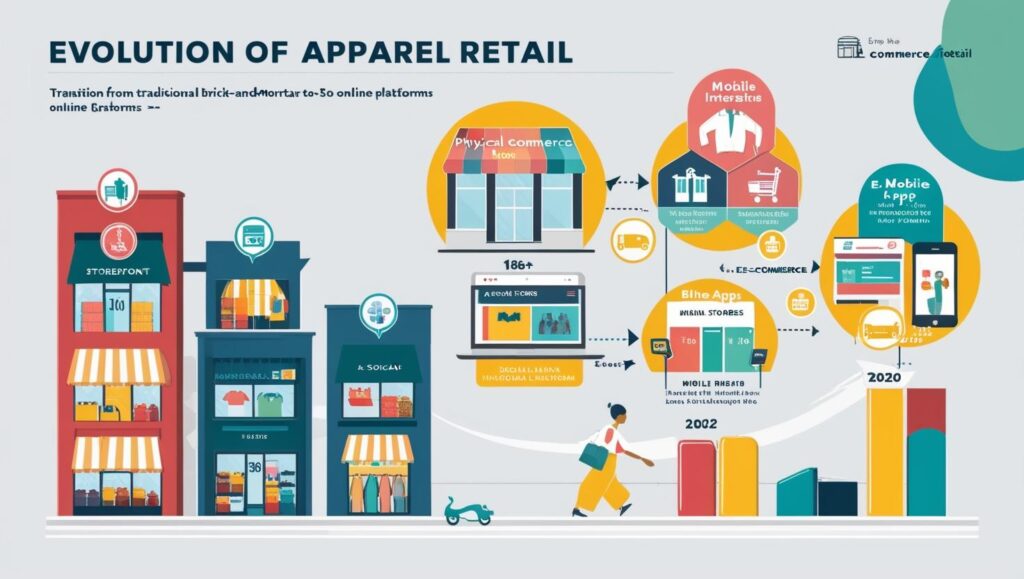The apparel retail industry has undergone a sea of change in the last couple of decades. The pure brick-and-mortar businesses today find their amalgamation into both physical retailing and huge online platforms, turning it way more intricate yet an exciting shopping experience altogether. Be it enterprise or entrepreneur indulging in an apparel business, one should know how both the worlds balance each other for sustainability and consistency towards the changing expectation of customers.
Is your business ready to maximize both in-store and digital retail experiences, or are you unsure how to make both a seamless fit in your strategy? Let’s go into detail on how apparel retail has evolved, and further discuss ways you can make the shift work for you by building stronger brand presence.
How Did Physical Retail Change Over the Years?
For years, the physical store was the foundation of the apparel retailer. From small boutiques to very large department stores, businesses worked on one principle: the more footfall, the more sales. Tactile exploration-touch and try-along with exposure to new trends in person drew customers into the stores. Yet retailers also catered to those niche relationships that they built with their local communities through customized shopping experiences.
This balance dramatically started to shift with the rise of online shopping in the 2000s. E-commerce began to hold a force all its own: far more convenient, with wider options and often cheaper. Yet, despite this growth, physical stores remain relevant. Shopping for an outfit remains a very sensory experience for consumers, in which there’s always that comforting feeling of trying items on before buying.
As a business owner, it’s important to understand that physical stores are no longer transaction places but rather destinations where customers can have a more intimate experience of your brand. These would include great customer service, great in-store experiences, and a fashion-forward staff that keep your physical store relevant.

Why Is the Online Apparel Market Booming?
It is an unsaid fact that the digital revolution hurt the traditional retail model. Today, e-commerce portals have opened doors for customers to buy fashion products from any part of the world. The modern consumer enjoys being able to shop 24/7, compare prices, and read reviews from the comfort of their home.
This apparel market has massively shifted to online platforms, especially in the post-pandemic scenario. It is this increasing demand for digital shopping experiences that’s really forcing them to change course. Social media, influencer marketing, and shoppable ads-all these help the brand create better experiences for their customers and influence their purchase decisions effectively.
In any apparel business of today, a great online presence is not an option but a compulsion for survival. Be it providing a fully e-commerce-enabled website or third-party platforms like Instagram and Etsy to showcase the designs, smooth online shopping is of utmost importance. What that means here is creating an inviting, virtual store that’s just as easy to use as it would be in person.
How do you bridge the gap between physical stores and online platforms? Probably one of the big challenges in the perspective of today’s business is how one can marry both physical and e-commerce into one coherent retail strategy. You may be doing all very well in a physical store, but are you really leveraging online retail to full effect? On the other hand, if you plunged headlong into e-commerce, is there physical touch that cements your brand as real?
Omnichannel selling does just this-merges online and in-store shopping efficiently. Provide them with click-and-collect options whereby customers could order online but have pick-ups in-store along with live web chats on your portal for responses. This would again make buying highly flexible.
This will also allow your physical store to act as a showroom for your online offerings, creating in-store and online traffic. For example, a customer walks into your store to try on an outfit, only to realize that the size they want is available only online. Give them the ease of ordering right from the store, and they leave satisfied, be it buying in-store or online.

Can Fashion Designers Shape Retail’s Future?
Being on top of the trends is crucial in today’s apparel retail marketplace. Business entrepreneurs and owners also have to cope with both changing consumer preferences and technological innovations to remain competitive in the market.
Equipping you for the future could be added to in a number of ways including an addition of more education and certification to your portfolio. For example, a two-year advance certificate in Fashion Design will help to understand both creative and business aspects of Fashion Design. Students will be better equipped to appreciate textiles, pattern making, garment construction, the latest retail technology, and engage customers.
Understanding apparel design in light of emerging trends for sustainability and personalization affords you unique value in an ever-changing retail landscape. Besides, a certificate program can actually give you some credibility to prove to your clients that your designs are trendy yet created professionally with attention to minute details.
What’s Next in Apparel Retail?
Future apparel retail will be innovative, whether it is AR for virtual fitting or AI using data to create a personalized shopping experience that caters to the taste of each individual. The possibilities are endless. But one thing is for sure: the lines between physical stores and online will continue to blur.
The question facing both business and entrepreneur alike becomes one of agility-how to prepare for, even move with changes that are coming upon them. By understanding both worlds, one positions themselves correctly to meet demands from today’s tech-savvy, experience-driven consumer.
Conclusion: Is Your Business Prepared to Evolve with the Clothing Retail Industry?
In fact, the evolving face of apparels retail is quite a great avenue for business and entrepreneurs to redefine the ways they go about both physical stores and online sites. It is here that omnichannel-meaning integration of these two worlds-will play a huge role in defining which brands make it big, along with a focus on customer experience and technology.
Whether it’s a fresher or a redesigning of your retail strategy, remember that education is one of the main ways to success. Join courses like the Two Years Advance Certification in Fashion Design to arm yourselves with the right skills to stay ahead in this ever-changing industry.


